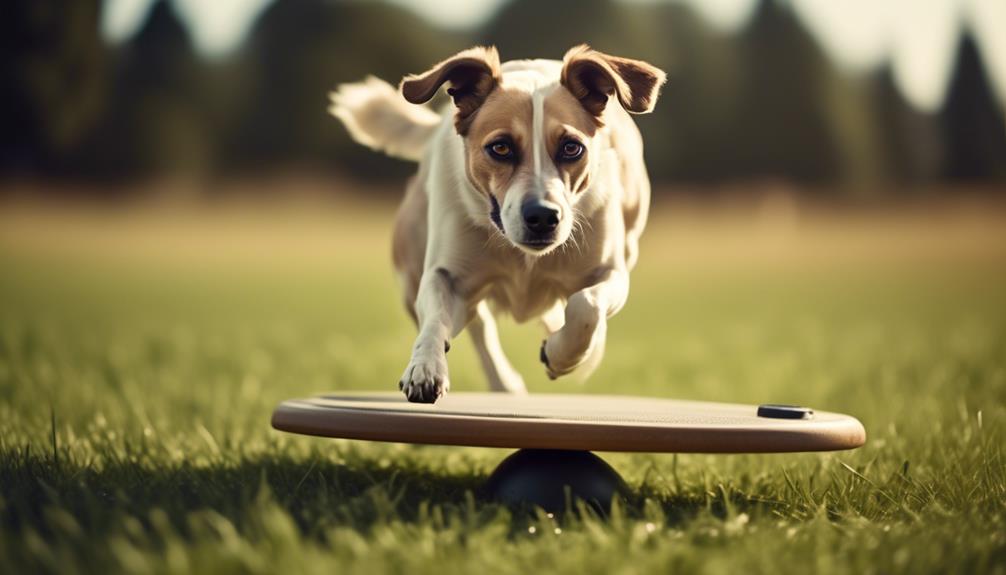In the calm stillness of recovery, the energy of a once-active dog waits to be reignited. Post-surgery life demands a delicate balance: fostering healing without hindering the spirit. You’re tasked with guiding your dog through this critical phase, armed with patience and a trio of rehabilitative exercises tailored to restore physical function.
Begin with passive range of motion exercises, gently encouraging movement in each joint to maintain flexibility without strain. Gradually reintroduce strength through short, controlled walks, keeping a watchful eye on your dog’s tolerance. And as progress unfolds, incorporate sit-stand exercises to rebuild muscle with the precision of a well-versed conductor.
Each step is pivotal, and while the journey requires dedication, the nuances of these routines hold the promise of a return to joyful, tail-wagging days. Stay tuned as we explore the specifics that can make a world of difference in your dog’s post-operative care.
Key Takeaways
- Gentle range-of-motion exercises, such as massaging the muscles and carefully extending and flexing the joints, can improve blood circulation and ease scar tissue after surgery.
- Assisted walking techniques using a harness or sling can provide support and stability during walks, gradually increasing weight-bearing on the surgical limb as confidence grows.
- Balance and stability workouts, including using balance pads and introducing obstacles, can improve limb strength and enhance core strength and balance.
- Controlled sit-stand exercises, starting with sitting and gradually increasing the duration of standing, can help rebuild muscle after surgery. Patience and monitoring are crucial throughout the rehabilitation process.
Gentle Range-of-Motion Exercises
Before starting gentle range-of-motion exercises, softly massage your dog’s quadriceps and hamstring muscles to enhance blood circulation and ease any scar tissue. This compassionate touch not only comforts your dog but also prepares their muscle groups for the physical activity to come. It’s extremely important to approach this with care, as your dog’s comfort and joint health are your primary concerns.
As you begin the gentle range-of-motion exercises, cradle each joint with a supportive hand. Extend and flex the limb’s joints carefully, repeating this motion 10 times for each joint, 2-3 times daily. These movements help keep your dog’s joints flexible and can reduce stress on the recovering areas.
To aid in their recovery, consider adding joint supplements to their diet as recommended by your vet. This can provide the necessary support for their joint health during the rehabilitation period.
Assisted Walking Techniques
Having established a routine with gentle range-of-motion exercises to maintain joint flexibility, it’s now time to support your dog’s recovery through assisted walking techniques.
As pet parents, keeping your dog happy and healthy is your top priority, and these techniques will help you do just that.
Start by using a harness or sling to provide the necessary support and stability. This will ensure you’re keeping your dog safe while they regain strength.
Take your dog for short, controlled walks, paying close attention to their pace and gait. It’s important to keep the walks at a gentle pace to prevent any strain on your dog’s healing body.
Try to keep these sessions positive and full of encouragement. As you notice your dog gaining confidence, gradually increase the weight they bear on the surgical limb, always following the guidance of your veterinarian.
Your dog’s comfort is paramount, so watch their body language closely. If you notice your dog showing signs of discomfort, adjust the support you provide.
Balance and Stability Workouts
To bolster dog’s recovery, let’s integrate balance and stability workouts that will enhance their coordination and strengthen their limbs.
Beginning with gentle exercises like standing on unstable surfaces—such as balance pads—can significantly improve their limb strength. Gradually, you can introduce controlled weight shifting, prompting your dog to stand on one limb at a time. This not only fosters stability but also boosts their proprioception, which is their sense of body position.
Incorporating balance discs or wobble boards into your dog’s daily routine can pose a delightful challenge, improving core strength and refining their balance. These tools provide both physical and mental stimulation, encouraging your dog’s brain to engage in the healing process actively. Think of these workouts as brain games that keep their mind sharp and focused.
For added variety, guiding your dog across uneven terrain, like sand or grass, can simulate natural challenges, promoting enhanced stability. As your dog progresses, you can introduce obstacles and hurdles, always ensuring the game to play is safe for their condition. Such activities not only aid in physical recovery but also encourage lymphatic flow, which is crucial for reducing inflammation and swelling.
Frequently Asked Questions
What Activities Are Good for Dogs After Surgery?
Post-surgery, you’ll want to gently massage your dog, take short leashed walks, and use cool compresses initially. Gradually, add more walking, sit-stand exercises, and mental games as they heal.
How Do I Exercise My Dog After Surgery?
To exercise your dog post-surgery, start with short, controlled walks, gradually increasing time and distance. Introduce gentle PROM exercises, followed by puppy squats and figure eights as they gain strength.
What Are the Therapeutic Exercises for Dogs in Rehab?
You’ll employ therapeutic exercises like PROM, careful walks, and mental games to help your dog heal. Remember to support them on tricky surfaces and increase activity levels.
How Can I Strengthen My Dog’s Leg After Surgery?
To bolster your dog’s leg post-surgery, embark on a journey of gentle massages, controlled walks, and strength-building exercises like puppy squats, always guided by your vet’s tailored advice for a compassionate recovery.


